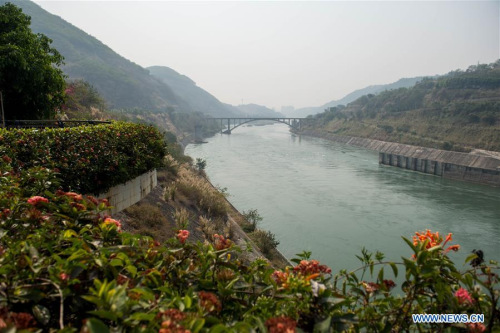
Photo taken on March 20, 2016 shows the lower reaches of Jinghong Hydropower Station in Dai Autonomous Prefecture of Xishuangbanna of southwest China's Yunnan Province. (Xinhua/Hu Chao)
Lancang-Mekong River Dialogue and Cooperation (LMC) helps enhance political mutual trust and practical cooperation as well as reciprocal and common development of relevant countries, senior vice president of Thailand's Kasikornbank said.
The LMC mechanism will boost regional economies on different development levels to realize resource complementation and balanced growth,Wichai Kinchong Choi told Xinhua in an interview prior to the first LMC leaders' meeting, to be co-chaired by China and Thailand on Tuesday in China's southern city of Sanya on Hainan Island.
This year is the opening year of Lancang-Mekong cooperation, and marks the first year of the establishment of the ASEAN community, the first cross-nation union in East Asia, and the 25th anniversary for the establishment of China-ASEAN dialogue relations.
According to Choi, Thailand and China, two outstanding economies among the six countries that are linked by the Lancang-Mekong River, could make full use of the relative low labor costs and rich natural resources in the other four countries -- Myanmar, Laos, Cambodia and Vietnam through the mechanism to transfer production capacity to improve their competitiveness at the global market.
As for the four countries with relatively weak economies, Choi said, the LMC mechanism will benefit them greatly in terms of economy and development, which will help those countries engage with the ASEAN economic community.
Since the first LMC foreign ministers' meeting was held in China's southwestern province of Yunnan on Nov. 12, 2015, the six countries along the river have reached wide consensus on the cooperation, he said.
One of the important moves under the LMC framework is to improve connectivity among member states, including not only speeding up infrastructure construction, but also promoting cultural and people-to-people exchanges.
In the view of Choi, infrastructure construction will lay a foundation for the development of neighboring countries and play a key role in their future sustainable development.
The planned China-Thailand railway project, a high speed line running across Thailand from north to south, will certainly bring great economic returns, he said.
Setting the five LMC priorities -- connectivity infrastructure development, economic, trade and investment promotion, water resources and environment protection, poverty reduction, and agricultural development -- will have a direct effect on narrowing the development gap between countries in the Mekong subregion, boost regional economic and social sustainable development and benefit local people, he said.
The ASEAN community's three pillars -- the economic community, the security community and the cultural and social community, coincide with the LMC's three key areas -- politico-security issues, economic affairs and sustainable development, and social affairs and people-to-people exchanges.
Choi said Thailand and China share a long history of cooperation in the three areas, and have become increasingly close, proved by booming bilateral economic and trade development, frequent cultural exchanges and close cooperation in military, anti-corruption, anti-drug and other fields.
The successful cooperation between the two countries that is based on mutual respect, mutual benefit and non-interference in each other's internal affairs, can serve as an example for China-ASEAN cooperation, he said.
With such a solid foundation, the first LMC meeting can further promote regional cooperation and benefit about 600 million people in the 10 ASEAN countries, the vice president concluded.
The framework of Lancang-Mekong River Dialogue and Cooperation was proposed by Chinese Premier Li Keqiang in November 2014 when he attended the 17th China-ASEAN leaders' meeting in Nay Pyi Taw, Myanmar.


















































